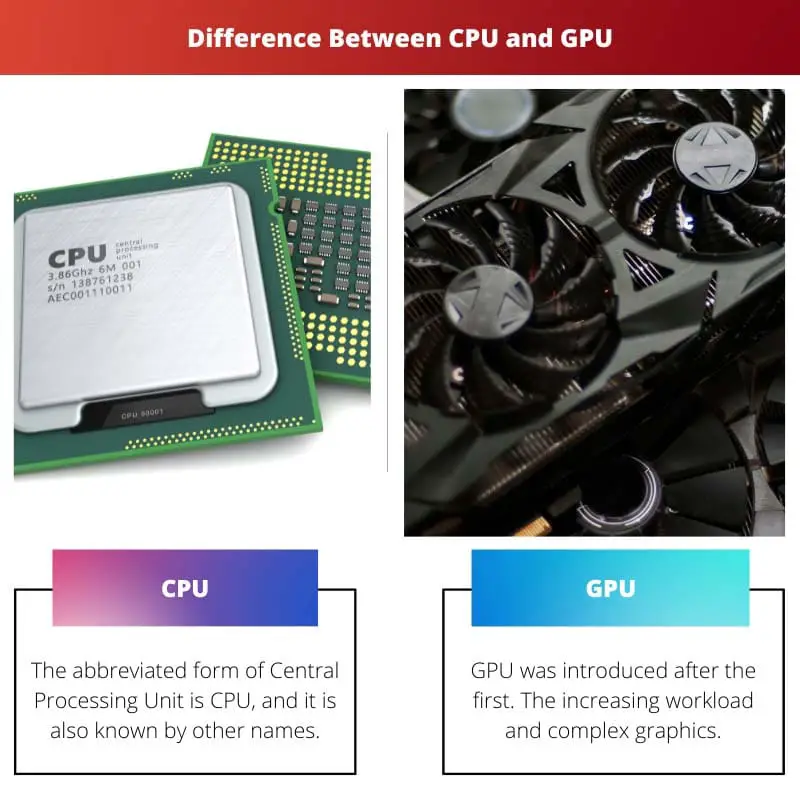We spend nearly half of our days on computers, whether for school, studies, or office work. We’ve noticed a significant increase in the workforce, and our computers occasionally hang.
Now, computers are equipped with cutting-edge technologies and adaptability, allowing us to complete tasks with clarity in a matter of seconds. Consider the computer your father used to work on.
The CPU is in charge of all of these functions, so what is this GPU? We’ll look at that in this article, as well as the differences between them.
Key Takeaways
- CPUs handle general-purpose computing tasks, while GPUs specialize in parallel processing for graphics-intensive tasks.
- CPUs have fewer cores but higher clock speeds, allowing them to execute tasks sequentially faster.
- GPUs have more cores with lower clock speeds, enabling them to process multiple tasks simultaneously and excel in tasks like rendering and AI.
CPU vs GPU
A CPU (Central Processing Unit) is a processor that acts as the brain of a computer or device, handling most of the instructions necessary for it to function. A GPU (Graphics Processing Unit) is a specialized processor designed to handle the specific needs of graphics-intensive applications.

The abbreviated form of Central Processing Unit is CPU, and it is also known by other names. It remains attached to the motherboard and monitors the computer’s every action.
It is a physical device that connects hardware and software. The CPU is a hardware device. It is thus referred to as the computer’s brain because it is in charge of the computer’s logical reasoning, calculations, and other functions.
GPU, on the other hand, was introduced after the first. The increasing workload and complex graphics that we deal with daily, it is said, put stress on the former.
As a result, the computers start to slow down because it takes a long time to provide the solution promptly. As a result, the GPU is used to reduce the workload of the former.
Comparison Table
| Parameters of Comparison | CPU | GPU |
|---|---|---|
| Known as | Central Processing Unit | Graphics Processing Unit |
| Consumption of memory | CPU requires more memory than the later. | GPU requires less memory than the former. |
| Speed | Lesser | More |
| Cores | CPU comprises better cores than GPU. | GPU comprises weak cores. |
| Is it suitable for processing serial instructions? | Yes | No |
What is CPU?
Let’s look at the characteristics differences between CPU and GPU while we’re on the subject. We already know what the CPU’s basic purpose is in a computer and how important it is.
Now, if we look closely, we can see that the CPU is slower than the GPU. Then, when it comes to the core, the CPU is the clear winner.
The cores are tiny but mighty. Parallel instruction processing is not suitable for CPUs, whereas serial instruction processing is. It also relies on lower latency when it comes to latency.
Also, know that the CPU has an Arithmetic Logic Unit, which allows it to perform complex calculations and other tasks. Memory, input, and output are the computer components with which it interacts to carry out instructions.
So, when it comes to the infrastructure or design of the CPU, it is designed to handle a wide range of tasks quickly. The clock speed of the CPU is used to make the measurement.
It is limited in terms of the number of tasks that can be run at the same time.
The former is more adaptable than the latter. In addition, the CPU and GPU, when working together, provide a powerful support system for the computer. And the pace quickens.

What is GPU?
Let us proceed directly into the differences, as we did with the full form of GPU. We’ve heard about the CPU; now it’s the GPU’s turn.
The GPU’s memory consumption is lower than the farmer’s. When it comes to speed, the GPU is likely to be faster. However, the cores that make it up are weak.
The CPU supports serial instruction processing, whereas the GPU does not. GPU, on the other hand, allows for parallel instruction processing. GPU, on the other hand, is more focused on high throughput.
Let’s see how the GPU, as previously stated, reduces the workload of the former. As a result, when a CPU is connected to a GPU, data throughput is increased and concurrent calculations are completed faster.
The original intent of GPU development was to process images for computer graphics and video game consoles. Then, starting in 2010, it was upgraded to improve the speed of calculations involving a large number of data points.
As a result, the main program runs on the CPU while a parallel arrangement runs on GPUs, reducing the CPU’s workflow.
As a result, the CPU handles all of the major tasks, while the GPU aids the CPU in completing the tasks more quickly and effectively.

Main Differences Between CPU and GPU
- The CPU and GPU stand for Central Processing Unit and Graphics Processing Unit, respectively.
- CPU requires more memory in comparison to GPU.
- The CPU is slower than the GPU.
- The CPU handles all of the major ide ranges of requests, while the GPU aids the CPU by monitoring narrower and more specific tasks.
- The number of ALUs in the CPU is less than that of the GPU.




